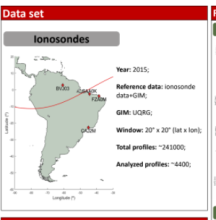Performance of COSMIC electron density profiles over the Brazilian region by means of ionosonde data: ionPrf versus igaPrf
Gabriel
Jerez
São Paulo State University
Poster
The Radio Occultation (RO) technique based on GNSS (Global Navigation Satellite System) data can be used to retrieve profiles from the neutral and the ionized atmosphere. RO data presents an important advantage compared to other techniques due to its spatial distribution, which enables global coverage. COSMIC (Constellation Observing System for Meteorology, Ionosphere and Climate) (2006-present) is one of the main RO missions, with significant amount of atmospheric data available, especially related to the ionosphere. In this work, we aim to evaluate the performance of two COSMIC electron density profiles: ionPrf, ionospheric profile obtained by the standard Abel inversion, and igaPrf, which is obtained through the application of Abel inversion aided by monthly mean NmF2, to take into account information on horizontal gradients in the ionosphere. The profiles assessment was performed over the Brazilian area (equatorial region), typically characterized by intense ionospheric variability. Periods of low and high electron content were used. The assessment considered foF2 values from RO profiles compared with values measured by ionosondes in the Brazilian territory and interpolated to the position of the occultations occurrence. The interpolation was performed using VTEC (vertical total electron content) values from global ionospheric maps (GIMs). UQRG (rapid GIM from UPC - Universitat Politècnica de Catalunya) products were used to interpolate the variability of the ionosphere between the ionosondes and the occultation occurrence locations.

Poster PDF